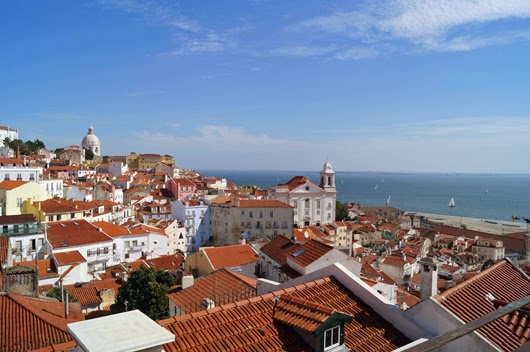< 1. Elvas surrounded by the brown rampart. A fortress look at hill of the right hand back. >
I introduce one of Fortified Town of Portugal today.
We visited here about 4:00 p.m. on October 18.
We looked at Elvas of a world heritage from the nearby Santa Luiza fortress.
今日はポルトガルの要塞都市の一つを紹介します。
私達はここに10月18日の午後4時頃訪れました。
近くのサンタ・ルジア要塞から世界遺産のエルヴァスを眺めました。
< 2. Santa Luiza fortress is shown at lower right side of this map. The light blue line shows an aqueduct bridge. The top of this map is the north. >
About Elvas
It is in 15 km position from the border with Spain, and the strong fortress was built on the hill from the 17th century to the 18th century.
Elvas is size of about 1 km of east and west, and has two fortresses of Santa Luiza and Graca to the south and the north.
These all have star-shaped rampart.
The aqueduct bridge of 7km in total length is in west side of Elvas and is still used.
エルヴァスについて
ここはスペインとの国境から15kmの位置にあり、17世紀から18世紀にかけて堅牢な要塞が丘の上に造られた。
エルヴァスは東西1kmほどの大きさで、その南北に、サンタ・ルジア要塞とグラサ要塞を持つ。
これらはすべて星形の城壁を持っている。
エルヴァスの西には全長7kmの水道橋があり、今も使用されている。
< 3. A full view of Elvas. The aqueduct bridge in left side. A rampart of Santa Luiza in front. >
< 4. A white building is central part of Santa Luiza fortress. >
Upper fig.: Elvas. Santa Luiza fortress is downward.
Lower fig.: Santa Luiza fortress. Elvas is downward.
上図:エルヴァス。サンタ・ルジア要塞は下方になる。
下図:サンタ・ルジア要塞。エルヴァスは下方になる。
The history
The history of this town began from the ancient Roman age of B.C.
Portugal that had been independent once in the twelfth century again achieved independence by war for Spain in the 17th century for 30 years.
This fortress was built at this time.
The mountainous area that separates Spain and Portugal is discontinuity at around Elvas.
その歴史
この地の歴史は紀元前の古代ローマ時代から始まる。
12世紀に一度独立したポルトガルは、スペインとの30年間戦争によって17世紀に再度独立を果たすことになった。
この要塞はこの時期に建設されたものです。
スペインとポルトガルを隔てる山岳地帯は、ここエルヴァス周辺では途切れている。
< 6. Distant view >
Upper fig.: view of south side from Santa Luiza fortress. Plain spreads out.
Lower fig.: view of Elvas and the aqueduct bridge from highway. Hilly areas spread out.
上図: サンタ・ルジア要塞から南方向を見る。平野が広がる。
下図: 高速道路からエルヴァスと水道橋を見る。丘陵地帯が広がる。
< 7. A panorama of Elvas of approximately 180 degrees from Santa Luiza fortress. >
The right hand is in the direction of Spain border, and the left hand is in the direction of Lisbon of Portugal.
右手がスペイン国境方向、左手がポルトガルのリスボン方向になる。
What I think
When we traveled on bus the Iberian Peninsula, there was often suburban town on the top of hills and cliffs, or slope.
Often, there is only one old fortress standing on the top of the cliff.
Furthermore, fortified town on the hill like Elvas is developing, and the people are living in here.
Although the scenery can be enjoyed very much, I have a certain question.
In Central European countries, Germany and Japan, even if a fortress stands on the top of a hill, the town belonging with it spreads in a plain field that have contacted with a river.
What does this difference mean?
A trip will be becoming interesting.
思うこと
イベリア半島を走っていると、郊外の町は丘や断崖の上、斜面にあることが多い。
また断崖の上に、ぽつりと古い城砦が建っている。
さらにこのエルヴァスのように丘の上の城砦内に市街が発展し、人々が今も暮らしている。
非常に楽しめる風景なのだが、ある疑問が沸く。
中欧諸国やドイツ、日本の都市の多くは、城が丘の上にあっても付属する市街地は川に接した平野部に広がる。
この違いは何を意味するのだろうか?
旅が面白くなってきた。
< 8. a underpass of Santa Luiza fortress >
This pass went to the lower town in those days.
It becomes continuous with the next time.
当時、下の町まで通じていた。
次回に続きます。































